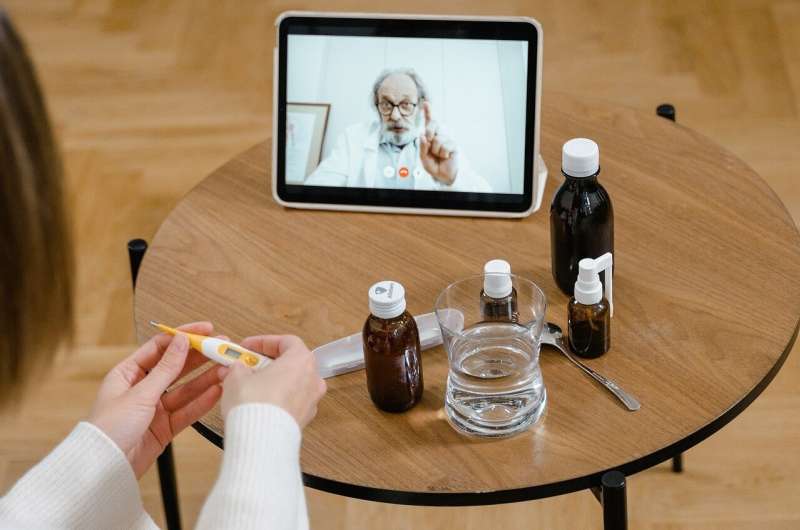

Telemedicine may be just as effective as in-person visits when it comes to shared decision-making and communication for patients undergoing a first-time surgery consultation, according to a study published as an “article in press” in the Journal of the American College of Surgeons and presented at the Southern Surgical Association 134th Annual Meeting in December 2022.
Telemedicine (also known as telehealth) has become an established part of patient care. However, its effectiveness to achieve proper shared-decision making between patients and clinicians—an essential part of quality care—had not been thoroughly studied previously. The COVID-19 pandemic necessitated a rapid expansion of the use of telemedicine visits, which allows patients and their health care teams to meet remotely through secure video-based platforms. It also makes specialty care, typically offered in cities, more accessible to patients living in rural areas.
“We see patients that live hours away. When the COVID-19 pandemic hit, it threw fuel on the fire of our telehealth program,” said study co-author Alexander T. Hawkins, MD, MPH, FACS, associate professor of surgery at Vanderbilt University Medical Center in Nashville, Tennessee.
“Across the entire health care system, we now do about 20,000 telehealth visits a month. Previously, there had been concerns about whether we could effectively communicate with patients remotely, but we found that patients are just as satisfied with telehealth visits as in-person appointments.”
For the study, researchers compared video appointments with in-patient visits for level of shared decision-making and quality of communication, hypothesizing that telemedicine would be less effective. Researchers enrolled 387 patients participating in first-time visits between May 2021 and June 2022 at general surgery clinics across Vanderbilt University Medical Center in Nashville.
Participants were categorized by type of visit: in-person or telemedicine. The aim was to evaluate the level of shared decision-making, as measured by a validated questionnaire called the collaboRATE Top Box score. Additionally, the 9-item Shared Decision-Making Questionnaire was used to assess patient satisfaction. An analysis of responses to open-ended questions about visits by both patients and surgeons was also performed.
Key findings
- The study included 301 (77.8%) patients who underwent an in-person visit and 86 (22.2%) who underwent a telemedicine visit. The two groups had similar demographic backgrounds, including age, gender, employment status, and education.
- Patients in both groups reported high levels of quality communication during these appointments.
- In an adjusted analysis to account for various factors, levels of shared decision-making and quality of communication were similar between remote visits and in-person care. Telemedicine was not associated with less satisfactory communication when compared to in-person visits.
- Patient responses to open-ended questions about their telehealth experience included positive statements about its convenience and usefulness. Negative comments about these visits included the inability to be physically present and experiencing technical difficulties.
“I was surprised by the qualitative responses. I expected that telemedicine visits would result in an inferior quality of communication. While we did see that in some responses, we also saw some very positive perspectives on telemedicine visits both in terms of how the actual interaction went and the overall convenience of the process. Many patients really enjoyed having this as an option,” said study co-author Thomas Ueland, a third-year medical student at Vanderbilt University School of Medicine.
Since telehealth visits do not allow for in-office physical exams, there are situations when it’s not appropriate. To that end, some surgeons reported that telemedicine should be used for follow-up care, after they have already established the relationship, instead of for first-time consultations.
“We believe these results suggest that either method, in-person or telehealth, is appropriate. Ultimately, it very much depends upon what the surgeon and the patient think is the best way to communicate,” Dr. Hawkins said.
“Going forward, we need to determine what is most appropriate for telehealth, and what is most appropriate for in-person visits. The data we generated in this study do give folks support, so that if they prefer telehealth appointments, they can be confident that they will not be sacrificing quality of communication or shared decision-making.”
Next, the research team will conduct more in-depth studies to identify a condition-by-condition guide for when telemedicine should be used, such as when patients are consulting for hernia surgery where a physical exam is required. For other patients, such as those needing follow-up care for routine operations, telehealth may be a viable option.
The major limitations of the study include the fact that the non-response rate from participants was more than 50 percent and that the patient population came mostly from middle Tennessee, southern Kentucky, and northern Alabama. These results may not apply to patients from other regions and of different demographic backgrounds.
More information:
Alexander T. Hawkins et al, Shared Decision-Making in General Surgery: A Prospective Comparison of Telemedicine vs In-Person Visits, Journal of the American College of Surgeons (2023). DOI: 10.1097/XCS.0000000000000538
Journal information:
Journal of the American College of Surgeons
Source: Read Full Article